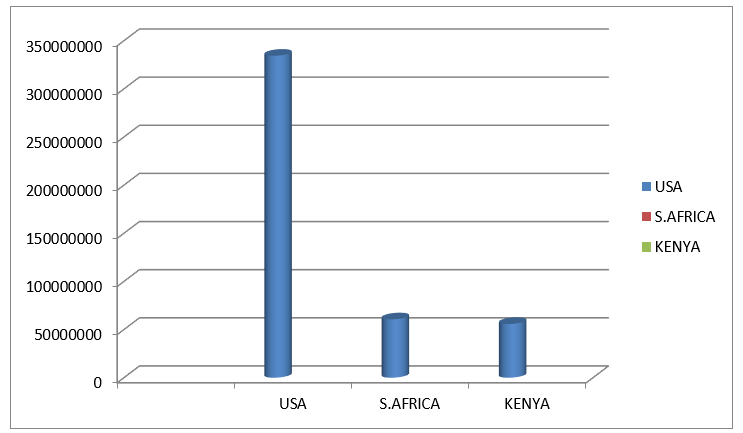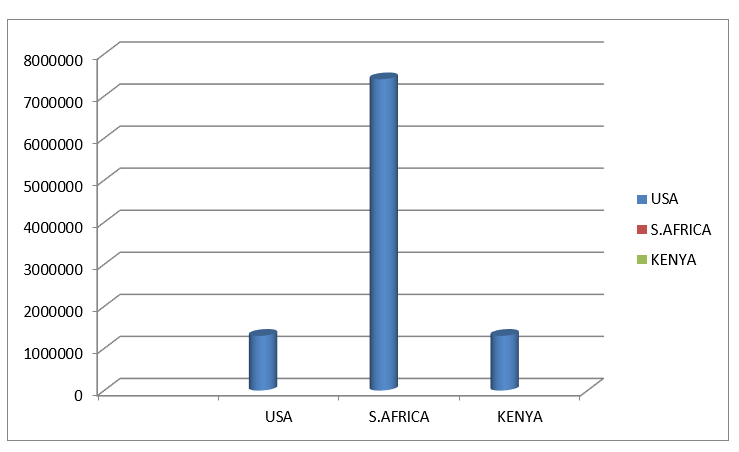Introduction – History of HIV
Scientist believes that HIV comes from a virus, particular from a chimpanzee in West Africa during the 1930s, and spread to the rest of the world through the fusion of blood through hunting. In this paper, the discussion entails HIV AIDS in the United States, South Africa and Kenya.
United States
According to Ragonnet et al. (2019), the united state of America is the world’s third-largest country in size and also almost the third in terms of numbers. Population stand at approximately 334,399,005 according to 2022 census. Report by the centre for Disease Control and Prevention (CDC), approximately 35,000 new HIV infection was observed in the united state in 2019. As cited by Saag et al. (2018), the data further revealed that approximately 1.3 million people in the united state have HIV. About 14 per cent of them do not know it and need testing.
Other statistic reveals that transgender people were accepted for 3% (701) of the 37901 new recoveries, male-to-female transgender people considered. women-to-men transexual indidual rated almost 2%(47 of new cases of HIV/AIDS identified. As demonstrated by Bershteyn et al. (2018).
According to Taljaard et al. (2020), gay, hermaphrodite, and other men who declare man-to-man sexual are most affected by HIV. By 2020, gay and hermaphrodite male rated 70% (26,662) out of 41,000 new HIV infection were recorded 87% of discoveries within men. According to Dewet et al. (2019), male and female who announced hetero were major disadvantaged. By 2020, hetero rated approximately 25% (9,900) out of 38,000 HIV discovered. Heterosexual men accounted for 10%(2,900). As argued by Ragonnent,et al,(2019).
According to Saag, et al. (2019), heterosexual women accounted for almost 18% (7000) of new HIV pronounced.drug users, according to 2019, accounted for 9% almost (2668) of the( 37000) men who inject drug deemed at 5% (1497) female who inject drugs were nearly 4% (182) of new diagnoses. There is a declining trend and common infection in the united state; numerous campaigns have achieved this, and it has been effective due to high literacy among the united state citizen. Further, this has been made possible due to the high standard of living.USA citizens have access to medication as compared to other countries. Reduction of the number of guys in America, predominantly known as a catalyst to infection among the gays’ population, as cited by Dewet et al. (2019).
South Africa
According to Achwoka et al. (2019), South Africa is one of the African countries that stretches more than 2505kilometer and has two oceans: the South Atlantic and the Indian ocean. According to the latest data by the united nation, South Africa has about 60,635,455 as of April. South Africa is one of the largest HIV epidemics globally, with almost more than 7.4 million people living with HIV. According to Ragnonnet et al. (2019), there was substantial geographic variation in HIV prevalence, ranging from 1.5% to 25.5%, with a median of 13% for men and from 4% to 51.1%, with a median of 22% for women. Many inventions noticed in South Africa are caused by the outlined factors, firstly low poverty among civilians; the majority of the South African population lack modicum education; this has caused rapid spread since some people are not aware of how this virus spreads. Again inadequate funds by the South African government to supply enough drugs and conduct awareness about HIV AIDS.As cited by Taljaard et al,(2020).
According to Saag et al. (2018), Irresponsible behaviour among youths has been affected since they indulge in unprotected sex. Further spread of HIV has been fueled by cultural precision among the south African, whereby some cultures are given the upper hand hence the infection were noticed. As cited by Achwoka et al. (2019), cultures like female circumcision, wife inheritance and local/traditional rituals, whereby people share sharp objects to cut or pierce their ears.Many of them are not aware of this practice, making them unprotected from HIV/AIDS. Since the late1990s, proof has been reached that initiation could be associated with lower transmission of HIV,those who were circumcise had a lower infection of HIV tranmission, as demonstrated by Bershteyn et al. (2018).
Kenya
According to Ragonnet et al. (20190, Kenya is a country in Africa, specifically in eastern Africa. Kenya has a population of 55,837,000, according to the latest united nation. In Kenya, around 1.3 million infected with virus HIV/AIDS, and 0.9 have died due to HIV/AIDS. There were 8000 fresh infection among minor age 1-15 years in Kenya, about 16% of all total new HIV infections in 2018.Achwoka et al. (2019) argued that these new HIV infections among children were condensed in the high prevalence counties in Kenya. Kenya has a nonexclusive HIV epidemic, with a prevalence among 15–49-year-olds estimated to be 6% in 2017 (6) and 5% in 2019 (7).By 2018,as cited by Saag et al,(2018)
According to Dewet et al. (2019),individual suffering from HIV/AIDS in Kenya are attributed to culture, poverty, negligence and lack of knowledge; some women have ventured into commercial sex as their livelihood. Some have encountered rape cases that they do not report and come for treatment. Through indulging in this act, they sometimes contract HIV/AIDS. Further government of Kenya has inadequate funds to create enough awareness among its citizens; hence some have not been fully aware of the risk associated with HIV/AIDS. According to Taljaard et al. (2020), barbaric culture has also mainly contributed to infection, such cultural circumcision of adolescents. Irresponsible behaviour adolescents have indulged in irresponsible sex. through the use of drugs, they have become irresponsible, and through this, a new infection has emerged. Drug addicts have shared syringes when abusing drugs, as cited by Achwoka et al. (2019).
As a health administrator, the following recommendations would help the united state continue minimizing their infection graph; those who already have the virus should be encouraged to continue using RVS, and again the government should also encourage citizens to take drugs. The United States should conduct door to door training and create awareness among its population. Through this, people will become knowledgeable about the importance of safe sex practices among citizens, training guys on how to minimize infection among them. For south African, responsible behaviour should be taught among the youths, especially university students, to know the value of life and service to the nation rather than leisure, which is detrimental to their lives. Culture abolition, some cultures are not healthy cultures, such as village circumcision of youths. Circumcision should be conducted in hospitals by health experts; Condoms use should be encouraged instead of unprotected sex. Government should distribute condoms to a public institutions of high learning. Lastly, the government should supply enough RVs to health premises to reach most youth. Kenya’s government should invest highly in awareness. This will give its citizen full knowledgable of HIV/AIDS. The government of Kenya should embark on job creation; this would help reduce HIV/AIDS since there will be a reduction of the social worker. Barbaric/outdated culture such as wife inheritance among some communities.
Conclusion
With the current surge of HIV/AIDS, different remedies and prevention have been put in place; for instance, in the united state, antiretroviral therapy (ART) involves taking a combination of HIV medicines every day. This helps people to live longer and longer. In Kenya, government and non-government organizations have introduced prep, this has helped to protect individuals from getting infected when taken within stipulated time after having unprotected sex. south Africa has invested more in culture build-up, they have trained young individuals to be responsible citizens, and through this, the rate of infection has primarily reduced. For instance, Kenya has self-test kits, where individuals can buy at affordable prices and text their status. Through that, many have known their status and role to take RVS.south Africa has come with strict measures on people who deliberately infect others, jail terms have been outlined, and strict measures have been placed on such people. All measure emplace are not perfect, but to some extent, they have helped and continues to help; measures such as preps should not be misused since some individuals might think it is practical, which sometimes is not the case; hence some individual might find themselves exposed to individual, The best remedy is being faithful to one partner, use condoms when you have to do it and above all abstain.
POPULATION PER COUNTRY

Number of HIV/AIDS PER COUNTRY

References
Achwoka, D., Waruru, A., Chen, T. H., Masamaro, K., Ngugi, E., Kimani, M., … & De Cock, K. M. (2019). Noncommunicable disease burden among HIV patients in care: a national retrospective longitudinal analysis of HIV-treatment outcomes in Kenya, 2003-2013. BMC public health, 19(1), 1-10 https://bmcpublichealth.biomedcentral.com/articles/10.1186/s12889-019-6716-2
Bershteyn, A., Mutai, K. K., Akullian, A. N., Klein, D. J., Jewell, B. L., & Mwalili, S. M. (2018). The influence of mobility among high-risk populations on HIV transmission in Western Kenya. Infectious Disease Modelling, 3, 97-106. https://www.sciencedirect.com/science/article/pii/S2468042717300532
De Wet, N., Akinyemi, J., & Odimegwu, C. (2019). How much do they know? An analysis of the accuracy of HIV knowledge among youth affected by HIV in South Africa.
Parker, A., Koegelenberg, C. F., Moolla, M. S., Louw, E. H., Mowlana, A., Nortjé, A., … & Taljaard, J. J. (2020). High HIV prevalence in an early cohort of hospital admissions with COVID-19 in Cape Town, South Africa. SAMJ: South African Medical Journal, 110(9), 0-0 http://www.scielo.org.za/scielo.php?script=sci_arttext&pid=S0256-95742020000900004
Ragonnet-Cronin, M., Hu, Y. W., Morris, S. R., Sheng, Z., Poortinga, K., & Wertheim, J. O. (2019). HIV transmission networks among transgender women in Los Angeles County, CA, US
Saag, M. S., Benson, C. A., Gandhi, R. T., Hoy, J. F., Landovitz, R. J., Mugavero, M. J., … & Volberding, P. A. (2018). Antiretroviral drugs for treatment and prevention of HIV infection in adults: 2018 recommendations of the International Antiviral Society–USA Panel. Jama, 320(4), 379-396. https://jamanetwork.com/journals/jama/article-abstract/2688574
 write
write